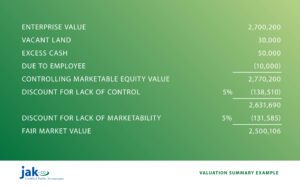If the events of the past year have caused you to rethink your current situation, you’re not alone. We’ve heard from many business owners who are wondering about the value of their businesses and if now is a good time to sell. If you’re in this boat, getting a valuation of your business can help.
First, what is a business valuation?
A business valuation is a process of assigning an economic value—that is, a dollar amount—to your business. As I mentioned, this is helpful to have if you’re considering your exit. You may also wish to get a valuation of your business if you’re planning your estate or vetting values for a merger or acquisition. You will be required to get a valuation if you’re transitioning your business to an ESOP.
Depending on the reason you need one, a business valuation involves a variety of analyses and methods. It also involves judgment on the part of the evaluator to determine the value of your company. This is typically based upon valuing your income stream (benefit stream) by utilizing projections or through historical earnings.
In most cases, the value of your company is the value of its future income potential to the buyer. Determining this involves looking beyond your company’s hard assets to intangibles such as customer relationships.
What is a business valuation report?
The result of a valuation is a final report, which can tally around 100 pages. This report explains how the valuator came up with your business’ economic value. Needless to say, if you aren’t a valuation expert, it can be intimidating. But it’s important to understand it, so you can feel confident in your valuator’s assessment. (If you don’t, you should question it.)
To help you better understand your valuation report, here are the five most important things you should take a look at.
1. Appraisal summary or reconciliation of appraisal value
This table gives you the conclusion (i.e., the final value of your business) and is typically found near the back of the report. This table tells you the value of your company and the methods your valuator used to determine the value. Valuators may select one method or weight multiple methods to reach a conclusion of value.

2. Summary of approaches and value indications
As I mentioned, a valuation typically involves a variety of methods for determining value; each can produce a different value. This summary shows how the value of your business varies between each method and there is a discussion within the report to explain why any method(s) is chosen over the others. Reviewing it can help you compare high and low values to the final value conclusion.

3. Normalizing entries
When working in a pdf, I always search for the word “normal” to see if there are any “normalizing adjustments.” Typically, this information is in a narrative format in the report. These are events that happen sporadically that could impact the value of your business, such as onetime expenses related to an unusual event or nonrecurring income such as the sale of a division. Also, the report could include adjustments for expenses that are not currently at market rate, such as rent if you were to own your company’s building or your own salary.
If you find normalizing adjustments, do you agree with them? Is there anything the valuator could have missed?
4. Discount rate summary
If the evaluator used the Discounted Cash Flow or Capitalized Income Method to determine the value of your business, you’ll want to review this summary. Most of the rates it includes are indexed; however, the amount of company-specific risk is subject to the valuator’s judgment. Be sure to search the document to find an explanation for the amount noted—a typical risk premium falls between 5–10%.
Note: If your business has had multiple valuations, you can compare the rates of each side by side to see what changed.

5. Business Valuation summary
Typically, the evaluator comes to an enterprise value or total value, but then factors in additions and subtractions to the value for items on the balance sheet that add to or take away from the value. In other words, these are items that the business doesn’t necessarily need to operate.
This table shows how assets and liabilities affected your business’ value. Did your valuator account for any non-operating assets or liabilities? Do you agree with the valuator’s assessment? Do you have any assets (e.g., a piece of land, excess cash) that aren’t listed? Did the valuator apply a discount for lack of marketability or lack of control?

Get insight into your business’ value
It’s important to understand how your valuator arrived at your business’ value—and this is where your valuation report can help. Thankfully, you don’t have to read every single page. Paying careful attention to the items I’ve mentioned here will give you a good idea of the factors that went into—or were left out of—your valuator’s judgment. If you have questions about your business’ value or would like to explore your valuation options, contact your JAK CPA today.
More Questions
What is The Importance of Valuation in Finance
Valuation is crucial in finance as it determines the economic value of an asset, company, or investment. It informs investment decisions, pricing strategies, mergers and acquisitions, and financial reporting. Accurate valuations ensure fair transactions and help in assessing growth potential and risk management.


